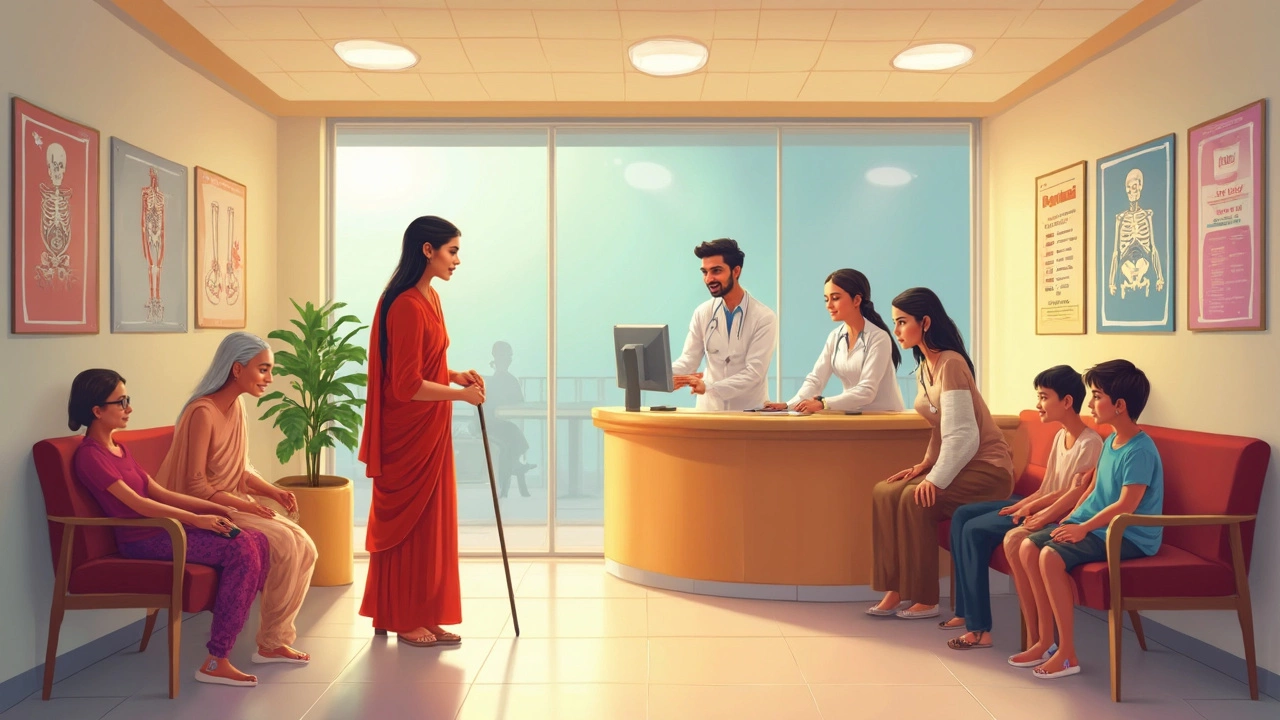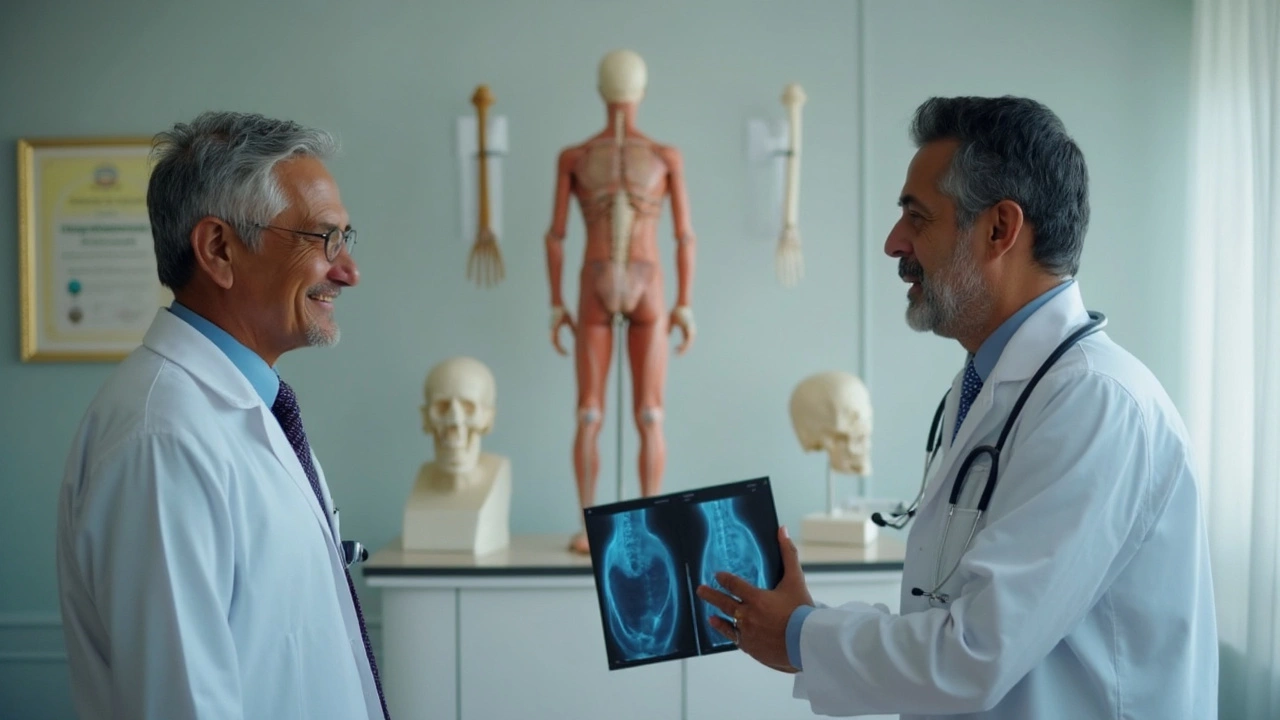- Home
- ::
- Which Doctor Is Best for Bones? Orthopedic Experts Explained

Which Doctor Is Best for Bones? Orthopedic Experts Explained
Break a bone, feel a weird ache in your knee, or notice your kid’s spine looks a bit off? You probably hear different names—bone doctor, orthopedic surgeon, rheumatologist—and wonder which is right for you. Nobody wants to waste time in the wrong waiting room. Here’s the shortcut: when it comes to bones, most people need an orthopedic doctor, also called an orthopedic surgeon. They’re the go-to experts for bones, joints, muscles, and everything in between.
Orthopedic doctors fix all sorts of bone issues—fractures, joint pain, sports injuries, and even replacement surgeries. If you’ve ever heard about someone getting a knee replaced or having pins put in a broken arm, that’s orthopedics in action. But here’s a curveball—not every bone problem needs surgery. Most orthopedic doctors spend a lot of time helping patients avoid the knife with therapy, exercise plans, or simple bracing. So, even if surgery freaks you out, don’t worry, you've still got options.
- Bone Doctors 101: Who Does What?
- Common Signs You Need an Orthopedic Specialist
- Types of Bone Problems and Who to See
- What Happens at an Orthopedic Hospital?
- How to Choose the Right Orthopedic Doctor
- How to Prepare for Your Orthopedic Visit
Bone Doctors 101: Who Does What?
This is where things get a bit confusing. There’s not just one type of doctor for every bone problem. Some fix broken bones. Others treat arthritis or bone diseases. It helps to know who does what, so here’s the breakdown:
- Orthopedic doctor: The main bone specialist. If you’re dealing with fractures, sports injuries, joint pain, or need surgery like a hip or knee replacement, this is your person. They do both surgical and non-surgical treatments.
- Rheumatologist: Handles diseases where the immune system attacks the joints—like rheumatoid arthritis or lupus. They’re not surgeons. If your pain comes with a lot of swelling or you hear the word 'autoimmune,' this is where you go.
- Pediatric orthopedic doctor: Kids’ bones are a bit different. These doctors manage things like growth plate injuries, clubfoot, and scoliosis in children and teens.
- Physiatrist: Sometimes called a rehab doctor, a physiatrist is all about getting you moving after an injury. They don’t do surgery but focus on recovery through exercises, physical therapy, and pain management.
- Endocrinologist: If your bone problem is because of hormones—think osteoporosis or brittle bones—they’re worth seeing. They deal with the chemical side of bone health.
Lots of cases need team effort. For example, a severe fracture might have an orthopedic surgeon fix the bone, a physiatrist help with rehab, and maybe an endocrinologist if weak bones are the real cause.
Just to give you an idea, here’s a quick look at how often people in the U.S. visit each doctor type for bone-related problems:
| Doctor Type | Average Annual Visits (U.S.) |
|---|---|
| Orthopedic Doctor | 30 million |
| Rheumatologist | 7 million |
| Pediatric Orthopedic Doctor | 3 million |
| Physiatrist | 4 million |
| Endocrinologist | 1.5 million |
If you remember one thing, make it this: for most bone, joint, or muscle problems, the first stop should be an orthopedic doctor. From there, they’ll point you to any extra specialists if you need them.
Common Signs You Need an Orthopedic Specialist
People put up with aches and pains way longer than they should. But not every sore spot goes away with rest or a hot pack. If you’re noticing problems that stick around or get worse, it’s probably time to see a orthopedic doctor. Spotting the signs early can save you from bigger trouble down the line.
Let’s get practical. Here’s when you really shouldn’t wait any longer:
- Constant or severe joint pain—especially in your knees, hips, shoulders, or back, even when you’re not moving.
- Swelling or stiffness that doesn’t get better after a few days of rest or over-the-counter meds.
- Chronic pain that lasts longer than 12 weeks.
- Limited movement in a joint—like you can’t fully bend or straighten your arm or leg.
- Bones or joints that seem to ‘pop’ or ‘click’ and cause pain.
- Weakness or numbness in your hands, arms, legs, or feet.
- Old injury acting up, especially if the pain returns or gets worse.
Take fractures and serious injuries seriously. If you heard a crack and now you can’t move a part of your body, or if it’s swollen and looks weird, skip home remedies—head to an orthopedic hospital fast.
Sometimes, the problem sneaks up slowly, like arthritis that just keeps eating away at your mornings. Other times it’s sudden, like when my dog Leo zigzags across the room and I trip, landing hard on my wrist. You want to catch these issues before they turn serious or permanent.
Here’s a quick look at how common these problems really are in India:
| Orthopedic Symptoms | How Common (India) |
|---|---|
| Knee pain (all ages) | Up to 30% of adults |
| Osteoarthritis (aged 45+) | About 22% of adults |
| Bone fractures (all ages) | 2 out of 5 will break a bone by age 65 |
| Back pain (working adults) | Almost 60% at least once in life |
If any of these sound close to home, it might be time to let an ortho check things out, instead of hoping for a miracle.
Types of Bone Problems and Who to See
Not all bone issues are the same. Some are sudden, like snapping your wrist playing football. Others creep up, like aching joints that get worse with age. Figuring out which doctor to see depends a lot on the type of problem you have.
Here’s a practical breakdown of common bone and joint problems, and who actually treats them:
- Orthopedic doctor: This is your main "bone doctor." They treat broken bones, joint pain, sports injuries, torn ligaments, and even bone tumors. You'll see them for most bone injuries and chronic joint pain.
- Rheumatologist: If your joint pain isn’t from an injury and feels more like swelling, stiffness, or if you have conditions like arthritis or lupus, a rheumatologist might get involved. They handle autoimmune diseases that affect joints and bones.
- Pediatric orthopedist: Kids get their own specialist if they have things like scoliosis or bone growth issues. They're trained for the unique stuff in growing bodies.
- Sports medicine doctor: For injuries related to sports or exercise that don’t need surgery, these doctors can step in. Think strained muscles, sprained ankles, or repetitive stress injuries.
- Endocrinologist: Surprised? These doctors help with bone health issues linked to hormones, like osteoporosis or Vitamin D problems.
Check out this handy table for a quick matchup:
| Problem | Best Doctor | Common Treatments |
|---|---|---|
| Broken bone (fracture) | Orthopedic doctor | Cast, splint, or surgery |
| Knee or hip pain (wear and tear) | Orthopedic doctor | Medication, therapy, replacement surgery |
| Rheumatoid arthritis | Rheumatologist | Medication, lifestyle changes |
| Osteoporosis (weak bones) | Endocrinologist / Orthopedic doctor | Supplements, medication, fall prevention |
| Child’s spine curve | Pediatric orthopedist | Bracing, monitoring, sometimes surgery |
| Sports injury (non-surgical) | Sports medicine doctor / Orthopedic doctor | Rest, therapy, possible surgery |
One thing people miss—a lot of bone and joint pain comes from using stuff the wrong way or too much. If your job or hobby pushes your body, you might want a sports medicine doc or a good orthopedic doctor before things get worse. Most of these problems get better the sooner you tackle them, so don’t wait around hoping pain will disappear on its own.

What Happens at an Orthopedic Hospital?
Most people picture a hospital as a place for emergencies, but an orthopedic hospital is set up for all sorts of bone and joint care, not just surgeries. Whether you walk in with a nagging shoulder pain or hobble in after a sports injury, there’s a process they follow to figure out what's wrong and how to fix it.
You start by seeing an orthopedic specialist. The doctor checks your symptoms, listens to your injury story, and does a hands-on exam. Expect them to move your joints around to check your pain spots or muscle strength. X-rays are pretty standard, and sometimes you’ll need an MRI or CT scan if the problem’s hiding deeper.
Here’s something cool—most top orthopedic hospitals have all their diagnostic and rehab services under one roof. You can get imaging, physical therapy, and even minor procedures done without leaving the building.
"The main goal is to get people moving well and living pain-free again. We use surgery only when nothing else works," says Dr. Anita Desai, lead orthopedic consultant at Sunrise Bone & Joint Center.
Treatment plans are rarely one-size-fits-all. Besides medications for pain or swelling, doctors might recommend:
- Physical therapy to get back strength and flexibility
- Braces or supports for injured joints
- Minimally invasive injections (like cortisone)
- Surgical procedures for serious injuries or chronic problems
Most folks are surprised how much can be fixed without going under the knife. According to the National Orthopedic Association, only about 1 in 10 patients seen in orthopedic hospitals actually need surgery.
| Service | What It Involves | How Common? |
|---|---|---|
| X-rays & Imaging | Pictures of bones/joints | 80% of patients |
| Physical Therapy | Custom rehab exercises | 65% of patients |
| Surgery | Operation for severe problems | 10% of patients |
The orthopedic doctor will usually work as part of a team—therapists, nurses, and sometimes dietitians—so you’re not dealing with a single person guessing at your care. This team-centered approach is one of the big reasons people get better faster in these hospitals.
Don’t forget to ask questions if you’re confused about any part of the process. Every good orthopedic hospital expects you to speak up, because fast recovery starts with clear info and a plan that makes sense for you.
How to Choose the Right Orthopedic Doctor
Picking the right orthopedic doctor can feel like diving into a sea of confusing titles and reputations. But it’s not rocket science once you know what really matters. The first thing to look for: board certification. This means the doctor has gone through serious training and passed tough exams just to work with bones and joints. If a doctor is a fellow of professional groups like the Indian Orthopaedic Association or the American Academy of Orthopaedic Surgeons, that’s a good sign too. It means they keep learning and stay updated.
Location also matters. You want a doctor or hospital with a solid reputation for bone care nearby. Ask around—chat with friends, family, or even people at your gym. You’ll be surprised how fast you’ll hear who fixed whose ankle or replaced a knee. Online reviews can help, but treat them like you treat movie reviews—too many five stars and zero negatives? Probably fake.
If you have a specific problem—let’s say chronic sports injury or a complicated fracture—check if the doctor specialises in that area. Some orthopedic doctors spend most of their time with athletes, while others deal with spine issues, kids, or arthritis. Don’t be shy about asking how many times they’ve treated issues like yours. Real pros won’t mind sharing their expertise.
It’s also smart to check basic stuff, like what insurances they accept and which hospitals they work in. You don’t want surprise bills. Plus, a hospital’s infection rates, success stats, and average patient wait times actually matter. Here’s a quick sample of what you might want to compare:
| Hospital/Doctor | Years of Experience | Joint Replacement Success Rate (%) | Average Wait Time (days) |
|---|---|---|---|
| Dr. S. Reddy, City Ortho Clinic | 18 | 97 | 3 |
| Dr. Patel, Sunshine Hospital | 12 | 94 | 5 |
| Dr. Ahmed, OrthoPlus Centre | 7 | 90 | 2 |
Your comfort around the doctor is key. If they rush you or don’t explain things in plain English, that’s a red flag. The best orthopedic doctor will answer your questions, break down your options, and never pressure you into quick decisions.
- Check if they're board-certified in orthopedics.
- Get real experiences from friends or trusted sources.
- See if they specialize in your particular concern, like sports injuries, spine, or pediatrics.
- Compare patient outcomes and wait times.
- Assure your insurance is accepted.
- Trust your gut—they should listen and make you feel understood.
How to Prepare for Your Orthopedic Visit
Heading to the orthopedic doctor doesn’t have to be stressful. A little prep work can help you make the most out of your visit and get better answers faster. Here’s what actually works, straight from real patients and top specialists.
First things first—dig up your medical records and any recent scans or X-rays. Orthopedic docs love details. If you got an MRI last year or had a cast two summers ago, bring those papers. Even a picture on your phone can help. Write down all the symptoms you’ve been having—when they started, what makes them better or worse, and whether they get in the way of everyday stuff like walking Leo or lifting groceries.
- List your current medications, including vitamins or supplements.
- Note any allergies, especially to meds or metal (relevant for surgeries or implants).
- Wear comfortable clothes so your doctor can check the affected area easily. Shorts or a loose shirt work great.
- Bring a buddy if you’re nervous or might need help remembering what the doctor says.
Bored in the waiting room? Use that time to note down any questions or concerns. Docs can talk fast; having a written list means you won’t forget the important stuff. Experts agree with this approach. As Dr. Michael Parks from the American Academy of Orthopaedic Surgeons points out:
"Coming prepared with questions and records saves patients time and leads to better outcomes. It’s teamwork between the doctor and the patient."
It might sound rare, but some orthopedic clinics collect stats on patient prep. Here's what they report actually helps visits run smoother:
| Preparation Step | Reduced Visit Time (%) |
|---|---|
| Brought previous images/reports | 30% |
| Medication/allergy list ready | 15% |
| Jotted symptoms/concerns | 10% |
Do a little homework before your appointment, and you’ll walk out with clear answers—and probably a lot less waiting around.

 Health and Wellness
Health and Wellness





Write a comment